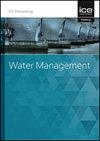用粒子图像测速法测量简单和复杂桥墩周围的高阶湍流
IF 0.9
4区 工程技术
Q3 ENGINEERING, CIVIL
Proceedings of the Institution of Civil Engineers-Water Management
Pub Date : 2023-02-16
DOI:10.1680/jwama.22.00017
引用次数: 0
摘要
本研究的目的是探索复杂桥墩(CP)周围流动和湍流长度尺度的高阶湍流统计,并将结果与简单桥墩(SP)的结果进行比较。流速数据是用粒子图像测速仪(PIV)在实验室水槽中记录的。分析了PIV数据,以估计三阶速度波动、湍流产生和耗散率、湍流长度尺度以及突发横扫事件对刚性平面上桥墩周围总雷诺剪应力的贡献。偏度和平流系数表明,与CP相比,SP的速度波动分布更不对称。抛射和扫掠事件表明,在桥墩下游,相似强度在较长一段时间内占主导地位。两个桥墩的上游TKE产量相似,而上游耗散率CP比SP高。长度尺度上,SP比CP上游值大,下游值小。研究结果表明,通过显示CP比SP更小的引起冲流的湍流参数,表明桩帽在限制向下移动的流动方面的重要性。本文章由计算机程序翻译,如有差异,请以英文原文为准。
Higher-order turbulence around simple and complex piers using Particle Image Velocimetry
The objective of this study is to explore the higher-order turbulence statistics of flow and turbulent length scales around a complex pier (CP) and compare the results with that of a simple pier (SP). The velocity data were recorded in a laboratory flume using Particle Image Velocimetry (PIV). The PIV data were analyzed to estimate the velocity fluctuations of third-order, turbulence production, and dissipation rates, turbulent length scales and the contributions of burst-sweep events to the total Reynolds shear stress around the piers mounted on a rigid flat surface. The skewness and advection coefficients indicate a more asymmetric distribution of velocity fluctuations for SP than that of CP. The ejection and sweep events illustrate the dominance of similar strengths for an extended period, downstream of the piers. The upstream TKE production was similar for both the piers, while the upstream dissipation rate is higher for CP than SP. The length scales show greater values at the upstream and lower values at the downstream of SP than CP. The findings show the importance of the pile-cap in restricting the downward moving flow by showing a lower magnitude of scour-causing turbulence parameters for CP than SP.
求助全文
通过发布文献求助,成功后即可免费获取论文全文。
去求助
来源期刊
CiteScore
2.10
自引率
0.00%
发文量
28
审稿时长
6-12 weeks
期刊介绍:
Water Management publishes papers on all aspects of water treatment, water supply, river, wetland and catchment management, inland waterways and urban regeneration.
Topics covered: applied fluid dynamics and water (including supply, treatment and sewerage) and river engineering; together with the increasingly important fields of wetland and catchment management, groundwater and contaminated land, waterfront development and urban regeneration. The scope also covers hydroinformatics tools, risk and uncertainty methods, as well as environmental, social and economic issues relating to sustainable development.

 求助内容:
求助内容: 应助结果提醒方式:
应助结果提醒方式:


